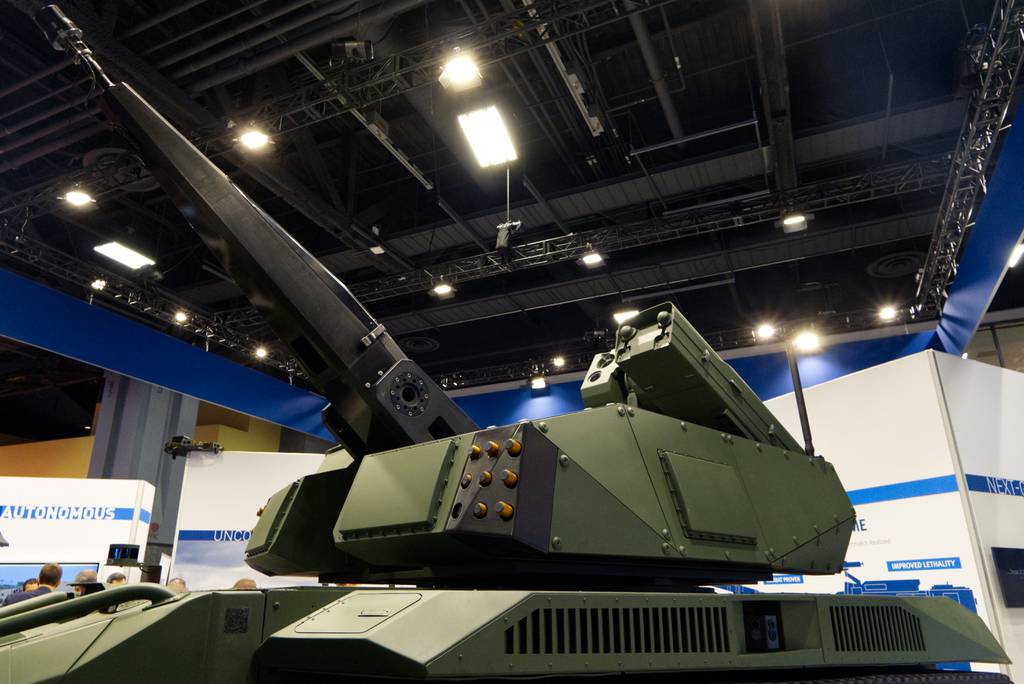WASHINGTON — American Rheinmetall introduced what the company said could be the future of short-range air defense, or SHORAD: the Skyranger 30 system, on display at the Association of the U.S. Army’s annual conference, wrapping up today.
What’s unusual isn’t the turret, which was debuted in 2021. The Skyranger can fire 1,250 30 mm airburst rounds per minute and elevate 85 degrees. What’s new is its pairing with the vehicle carrying it — an unmanned ground vehicle, or UGV.
On the show floor at the giant defense exposition, the turret sat atop a RIPSAW M5, a robotic UGV produced by Textron Defense Systems, one of Rheinmetall’s partners.
This pairing presents two main variations on the mean for SHORAD.
First, the M5 is smaller than the vehicles the Army typically employs for its air defense. According to Textron, its combat weight is around 10.5 tons, far lighter than the SHORAD-carrying Stryker.
Second, and more importantly, the M5 is unmanned. This is key to American Rheinmetall’s thinking, said CEO Stephen Hedger, speaking to Defense News next to the cannon on Oct. 10.
“People have not been thinking about SHORAD in a UGV capacity,” he said.
Combining the two components, he argued, is an attempt to anticipate a moving target: the Army’s increased focus on air defense and on unmanned vehicles.
After divesting in air defense artillery in the early 2000s, the U.S. Army is now pursuing new mobile SHORAD systems, including those that can defend against the drones that have proved so menacing on the battlefields in Ukraine.
Hedger touted the Skyranger’s ability to do just that. The turret is designed to counter unmanned aerial systems, or UAS. Within three kilometers, Hedger said, the cannon’s kill rate is 90%.
“The requirement for a more lethal SHORAD system that can address a swarm [of drones], that can address a larger and more complex UAV, a maneuvering UAS, loitering munitions is absolutely clear,” Hedger said.
Stacking this turret atop the M5 couples two trends: the Army’s shift toward unmanned vehicles and the increasingly on display need to defend against drones. In other words, it’s an example of a robot-killing robot.
“We certainly wanted to demonstrate here the ability for this type of turret to be integrated with this type of system on a platform like the M5,” said Hedger, who noted that the Army first resolved its interim SHORAD solution but is still looking to the future. “Where the Army may well be headed is a platform like the M5.”
The Army is now responsible for the air defense of Guam, and Hedger mentioned the Skyranger turret’s capability could fit such a scenario.
American Rheinmetall is not the only company with SHORAD experiments on display at the AUSA conference.
BAE Systems featured its new armored turret, which it hopes can eventually swat drones, atop of an armored personnel carrier it’s developing for the Army. General Dynamics loaded the SHORAD system usually carried by the Stryker atop its unmanned TRX, competing for the Army’s robotic combat vehicle light program.
Noah Robertson is the Pentagon reporter at Defense News. He previously covered national security for the Christian Science Monitor. He holds a bachelor’s degree in English and government from the College of William & Mary in his hometown of Williamsburg, Virginia.








